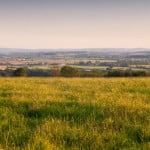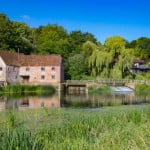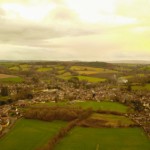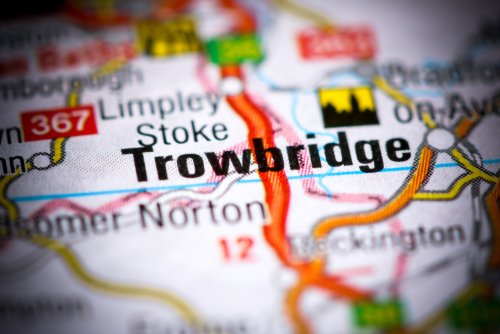
Trowbridge is an ancient market town and civil parish in Wiltshire, southwest England. Situated on the River Biss, its 8 miles (13 km) south-east of Bath, 38 miles (61 km) south of Gloucester and 20 miles (32 km) south-east of Bristol. Although it’s only the third biggest settlement in Wiltshire by population, it holds the county town status. Historically famed for its woollen industry, by the early 19th century it had been dubbed ‘The Manchester of the West’. At the 2011 census, the civil parish of Trowbridge had a population of 33,108.
A Brief History
The exact origin of the name Trowbridge remains uncertain although some think it to be a derivation of “Tree Bridge”, referring to the first bridge in the area over the River Biss. Another school of thought is that it is derived from “bridge by Trowle”, a hamlet and a common, just to the west of the town.
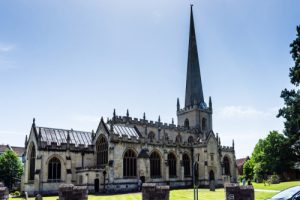
Parts of St Steven’s date from the late 12th century Image: Starsphinx/Shutterstock.com
Little seems to be recorded of Trowbridge’s earliest history except by the 10th century it had an Anglo-Saxon church. By the time of the Domesday Book of 1086, it was a settlement of 24 homesteads with a population of about 120. There is written reference dated 1139 to the ‘motte and bailey’ Trowbridge Castle, which was probably built by the Norman Lord Humphrey I de Bohun. His great-grandson, Henry de Bohun, born in 1176, became Lord of the Manor when he was around 15 years old. He became highly influential in shaping the medieval town and built St James’s church, the first in the town that was outside the castle grounds.
In 1200, Henry de Bohun was created Earl of Hereford by King John. He obtained a charter for a weekly market and annual fair for Trowbridge. He commissioned the laying out burgage plots for traders, typical of the time, meaning Trowbridge quickly became established as the principal town in the area. However, Henry was later viewed as a threat by King John and the barony of Trowbridge was taken from him. Henry joined forces with the other disenfranchised barons who opposed King John’s arbitrary and unpopular rule. In 1215, John was pressured into signing the Magna Carta (The Great Charter) at Runnymede, in order to bring about harmony within the ruling classes. Henry was elected as one of the 25 enforcers of the Charter. A little time after Runnymede, Henry regained control of Trowbridge meaning his family would dominate the town for more than the next century.
From the 14th century, Trowbridge developed as a centre for woollen cloth production bringing the town increasing wealth and prosperity. In fact, the town gained an international reputation for producing high-quality cloth and in time received special orders from royalty across Europe. When renowned traveller, writer and social critic, John Leland, passed through the town in 1540, he declared that Trowbridge ‘flourished by drapery’.
Trowbridge Joins The Industrial Revolution
During the 17th century, production of woollen cloth became increasingly industrialised. However, as time progressed, mechanisation was resisted by many workers who believed it was putting their jobs were at risk. From 1785 onward, protests against the introduction of machines became increasingly vociferous, eventually spawning the Luddite Movement of the early 19th century. In 1803, 19 years old local mill apprentice, Thomas Helliker, became a martyr for the cause when he was found guilty of sedition and hanged at Salisbury’s Fisherton Jail. He is buried in the graveyard at St James’s Church in Trowbridge.
In 1805, Abraham Bowyer established a grocers shop in Trowbridge. The company became known for its meat products, especially sausages, eventually becoming one of the towns biggest employers. Trowbridge also continued to scale up its production of wool cloth, such that by 1820, it had more than 20 such factories, earning it the dubbing of the “Manchester of the West”. In 1824, Thomas Usher and his wife, Hannah, acquired a small brewery in the town, renaming it Usher’s Wiltshire Brewery. Increasing job opportunities in the town became a catalyst for population growth. While in 1801, Britain’s first national census recorded that Trowbridge had a population of 5,799, by 1831, it had almost doubled to 10,863.
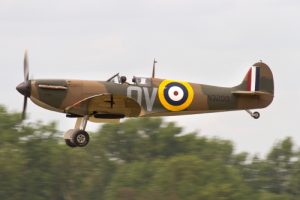
The ‘Spitfire’ was built at Trowbridge during WW2 (Photo Credit: Kev Gregory)
Throughout the 19th century, with increasing amenities available in Trowbridge, life improved for many. The town gained gas street lighting in 1824, the railway arrived in 1848, Market House was built in 1861, the first hospital in opened in 1870, a piped water supply was available from 1874, and the People’s Park opened in 1884. On the downside, the town’s woollen cloth industry was in terminal decline. In the late 19th century, an event which accelerated this downturn was the invention of the ring-spinning machine. The industry’s decline in the town continued throughout the 20th century.
During WW1, it was in Trowbridge that the Royal Horse Artillery mustered before they left to go to war on the 4th August 1914. A total of 289 local servicemen would not return home from The Great War. During WW2, Trowbridge more than did its fair share in the war effort as a great number of Spitfires were built in factories across the town. Both British and American troops were also stationed in the town’s army barracks, with the numbers increasing in the period running up to D-Day. In July 1942, Trowbridge was hit by several bombs dropped by stray Luftwaffe aircraft. One bomb demolished Bridge House, killing two women who had been standing on the bridge. It also blew the roof off the town’s historic Blind House (see below).
After the war, industrial land was made available at Ladydown and Canal Road. This enabled company’s like Airsprung and Walden’s to grow much more quickly than previously possible by the opening of large factories. By 1951, the population of Trowbridge had grown to 13,844. However, quite tellingly, this was only 27% higher than it had been 120 years previously.
The Modern Era
After a period of stagnation in the 1960s, Trowbridge, like many towns across the UK, has experienced mixed fortunes. In 1974, Castle Place Shopping Centre was opened. By 1981, the population had grown to 22,984, representing a growth of some 66% in only 30 years. Also in 1981, the White Horse Business Park opened, attracting major companies such as Virgin Mobile and Vodaphone. In 1982, the town’s wool industry finally came to an end when Salter’s Home Mill, closed its doors. However, in July 1990, the mill reopened, but this time as Trowbridge Museum, with display’s that tell the story of the town’s history. Also in the same year, the Shires Shopping Centre opened.
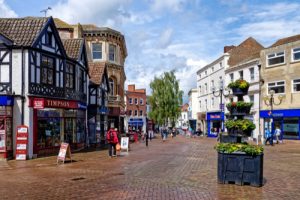
Fore Street is one of the town’s main shopping area’s. (Photo Credit: Andrew Harker)
In 2000, Usher’s Brewery, the town’s second-largest employer of the time, became a victim of changing times and was forced to close after the second attempt of a management buy-out, failed. The equipment was sold to the North Korean state-owned brewer, Taedonggang Brewing Company, located just outside Pyongyang. The remaining pub operator company was renamed Innspired Pubs plc, eventually being bought by Punch Taverns in September 2004. Today, beers are brewed under the Usher name by the Wychwood Brewery in Witney, Oxfordshire for Refresh UK. The former brewery site has undergone redevelopment over a number of years with some of the old buildings being incorporated into town centre apartments. In 2009, the old bottling plant was developed as a Sainsbury’s supermarket, a public square and more housing. Meanwhile, in April 2008, Bowyer’s who had been in the town for more than 200 years and one of it’s largest employers, closed down. Their operation was move to factories in Shaftesbury and Nottingham.
One of the biggest events in the town’s calendar is the annual 3-day Trowbridge Festival, which takes place at Stowford Manor Farm and is normally scheduled for the third weekend in July.
Trowbridge is twinned with four towns: Oujda in Morocco, Leer in Germany, Charenton-le-Pont in France and Elbląg in Poland.
Visiting Trowbridge
So you fancy paying this wonderful old Market Town a visit but not sure of the best way to get here? Don’t worry we have you covered.
By Road
Trowbridge is about 18 miles (29 km) from Junction 18 of the M4 motorway (Bath) and the same distance from junction 17 (Chippenham). The A361 runs through the town, connecting it to Swindon to the north-east and Barnstaple to the south-west. The primary north-south route passing closest to the town is the A350 which runs between Poole on the Dorset coast and Junction 17 of the M4.
By Train
Trowbridge is well served by trains. The average journey time between London Paddington and Trowbridge is around 2 hours 25 minutes, with 4 trains making the journey, daily. Trowbridge is also a stop on the Wessex Main Line (Bristol–Westbury–Southampton) and the Heart of Wessex Line (Bristol–Westbury–Weymouth). The local train service which serves Melksham, Chippenham and Swindon is operated by TransWilts.
By Coach
There’s one direct coach per day between London Victoria bus station and Trowbridge operated by National Express. The journey should take less than 4 hours and leaves London around 8.30 am. From other parts of the country, it’s probably best to head by coach to Bristol and change for Trowbridge from there.
By Air
The nearest airport is Bristol Airport, which is 30 miles (48 km) west of Trowbridge.
Notable people
Some notable people who were born or have lived in Trowbridge are:
- Sir Isaac Pitman (1813 – 1897) – the developer of the Pitman shorthand writing system was born in Trowbridge in 1813. The system was adopted across the world and is still widely used in the UK today. Pitman was knighted by Queen Victoria in 1894.
- Matthew Hutton (1693 – 1758) – was a high flying churchman who became Archbishop of Canterbury in 1757. He was the Rector of Trowbridge from 1726 to 1730.
- George Crabbe ( 1754 – 1832) – was an English poet, surgeon and clergyman who was the Rector of Trowbridge from 1814, until his death in 1832.
Did you know?

Usher’s Brewery equipment was shipped to Pongyang, North Korea in 2000
- According to a rumour circulating in North Korean in 2000, the women of Trowbridge had forced the closure of Usher’s brewery (see above) because they had simply had enough of the town’s menfolk getting drunk every day.
- Matthew Hutton, a former Rector of Trowbridge, was appointed Archbishop of Canterbury but never took up official residence at Lambeth Palace. He died in 1758 after less than a year in the position.
- In 1533, Henry VIII’s government introduced the ‘Acte for the punishment of the vice of Buggerie’. In 1540, Walter Hungerford, the owner of Farleigh Hungerford Castle (4 miles from Trowbridge) became the only man to be executed under the Act during the whole of the Tudor period. The Act remained on statute until 1861.
Sport
Trowbridge Town FC
Trowbridge Town FC is an amateur team who currently (2020) play in the Wiltshire League. Nicknamed ‘The Bees’, they play home games at Woodmarsh.
Trowbridge RFC
Trowbridge Rugby Football Club currently (2020) play in the South West 1 East League. Their home ground is at Hilperton, just to the northeast of the town.
Trowbridge Cricket Club
Trowbridge Cricket Club’s first XI currently (2020) play in the Wiltshire division of the West of England Premier 3. They play home games at the Trowbridge Cricket Club Ground, which is also used by Wiltshire’s county team.
Things to see and do!
Some of the things to see and do in and around Trowbridge are;
- Trowbridge Museum – is housed in the last mill that produced the famed West of England cloth, closing in 1982. It exhibits a comprehensive range of old machinery and artefacts used in the local cloth-making industry.
- St James Church – originally built in 1190, most of the present building dates from the late 15th century. The church features 31 gargoyles and tomb slabs dating back to the 12th century.
- Blind House – located next to Town Bridge, dates from at least 1758 and probably much earlier. The windowless building was used to hold prisoners for brief periods and was in service up until 1854. It’s part of the Trowbridge Trail.
- Southwick Country Park – is 100 acres (40 ha) of green pastures, located on the edge of Trowbridge. There is a series of small fields and parks which display a wide range of plants and shrubs. There also plenty of animals such as goats, cows, alpacas, horses and poultry at the Hope Nature Centre. There’s a small cafe on-site as well.
- Westwood Manor – dates from the 15th century and is a mix of late-Medieval, Tudor and Jacobean architecture. The manor houses a collection of 17th-century artefacts. There are also attractive topiary gardens. It opens on Tuesdays, Wednesdays and Sundays from April to September.
- Picket and Clanger Wood – is 150 acres of mixed woodland south of Trowbridge, cared for by the Woodland Trust. A must-visit for nature lovers it remains largely unchanged since its mention in the Domesday Book. Expect to see plenty of wildlife and flora.
- Kennet and Avon Canal – runs for 87 miles between Reading and Newbury, roughly following the course of the River Avon. Should you fancy a day (or even a week) on the canal you can hire a narrowboat at the nearby Tilperton Marina.
- Farleigh Hungerford Castle – which is sometimes called Farleigh Castle or Farley Castle, is a medieval castle about 4 miles from Trowbridge. The 14th-century unusual quadrangular castle is mostly in a ruined state but the eastern gate has been restored to its former glory. The castle has a fascinating history with many tales of woe.
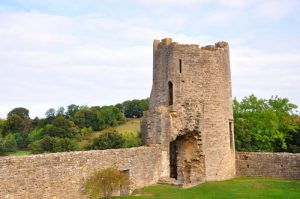
Part of the ruined Farleigh Hungerford Castle – located about 4 miles from Trowbridge
Where to stay?
There’s a very limited amount of accommodation in Trowbridge itself. Staying in Westbury (3-4 miles) or Bradford on Avon (4 – 5 miles) or the numerous close-by villages will give you more options. If you opt to stay in Bath, 7-9 miles away, you can take your pick from a wide range of accommodation types. A rough guide to prices for 2 adults sharing, staying in the general area of Trowbridge is £70 – £150 per night for either a guesthouse or hotel, depending on standard and location.
Moving to Trowbridge?
Thinking of moving to Trowbridge? The average selling price for all property in Trowbridge for the year up to August 2020 was approximately £238,500. This represents a rise of about 1% on the previous 12 months. In terms of property types, flats sold for £143,000, terraced houses for £193,900 and semi-detached for £231,000.
Note: All photos credited as shown and Shutterstock.com

